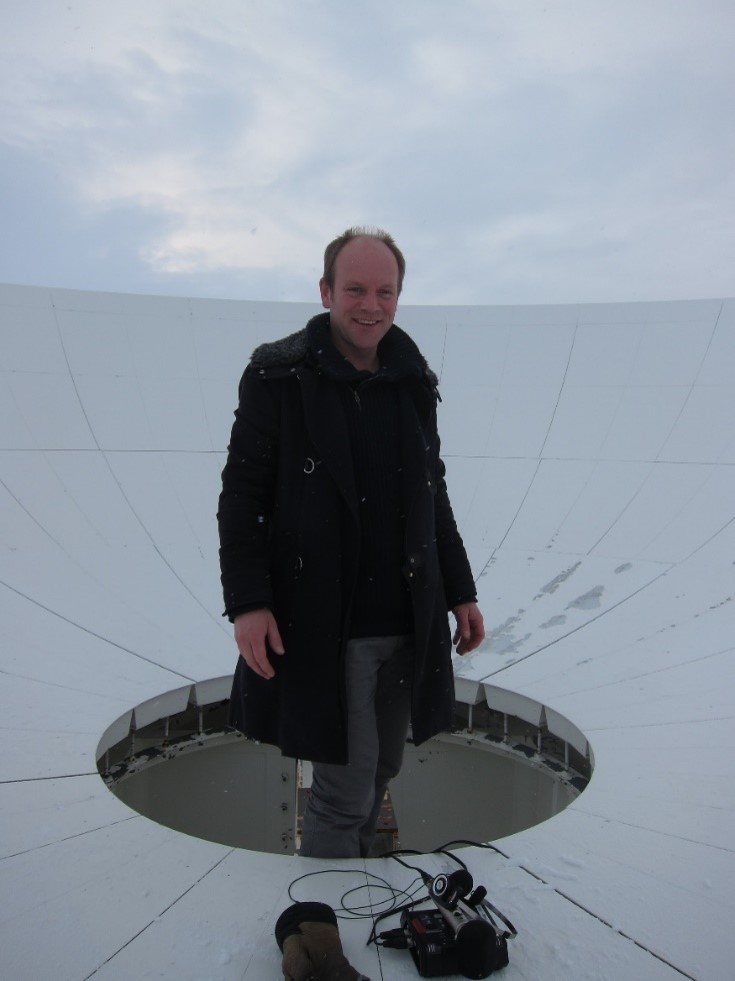VLBI Music
The sound installation VLBI Music was made for the Norwegian mapping authority, commissioned by KORO (Kunst i offentlig rom / Public Art Norway).
Opened November 2013, running time: 7 years!

Øyvind Brandtsegg in the VLBI antenna at Ny-Ålesund, Svalbard
A live stream from the installation can be heard here:
I wanted to make a work that would represent and reflect on the activity performed by the mapping authority. The need for a stable reference is essential in all kinds of map making, and in relating the map to the real world. Parts of our globe moves in relation to each other (continental drift, earth tide), the globe itself spins at a variable speed and its axis of rotation may change. All of this makes it hard to determine a stable reference point on earth itself. As in ancient times, we look to the stars for navigation. Using distant quasar stars and a measurement technique called VLBI (Very Long Baseline Interferometry), we can get this stable reference. This reference is used to calculate earth surface positions in relation to satellites (e.g. for GPS) down to millimeter precision.
What is artistically interesting about this (apart from working with a signal that originated more than a billion years ago) is the fact that the signal from the quasars is extremely noisy. It is buried in cosmic background noise, and furthermore, the signal itself can be characterized as white noise. Looking for a needle in a haystack would be relatively easy… I find it deeply poetic that we as humans have developed techniques to make sense of such a chaos. Perhaps we can also see this as a mirror of our capability to orient ourselves in the rich information flow we are exposed to every day as citizens of a modern society.
The composition and development of musical themes, sound structures and internal features of the sounds are all based on different aspects of the VLBI system as used in observation and calculation.
In particular, we could mention correlation techniques used in the precise calculation of position for each separate observation antenna in relation to other antennas. When a signal is noisy, one observer cannot make sense of it, but two or more observers working in common can find the meaning behind the noise. Translated to sound in this installation, correlation can be found in the sliding and gradual tempo adjustments made to different rhythm patterns, making the patterns slowly converge and synchronize.
The VLBI technique and the global network involved in it has revealed a myriad of poetic aspects, as I’ve learned while trying to grasp the technical issues involved. For example, the VLBI network involved deep cooperation and regular data exchange between Russia and the USA even during the cold war. I discovered another poetic and political aspect while looming over a data set representing the position of the VLBI antennas as (seen from the quasar): these position traces showed a collection of high amplitude traces and a collection of low amplitude traces, but a very visible “missing band” in the middle range. When I asked Alan Roy at the MPIFR about this he immediately replied: “Oh that is due to the distribution of wealth on earth, as there are many more antennas in Europe and the USA than elsewhere”. … so even from a distance of a billion light years, the uneven distribution of goods on planet earth is blindingly obvious.
More information about this work can be found at the website VLBI Music
Tags: soundart, music, selected